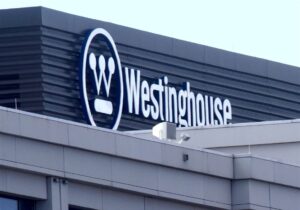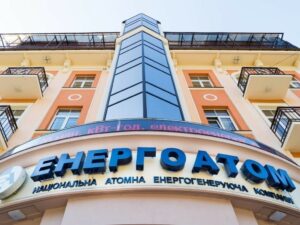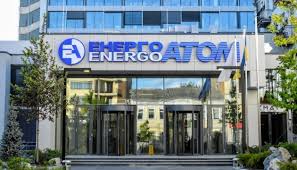
Westinghouse is discussing with Energoatom the production of individual modular units for AP1000 reactors in Ukraine, particularly in the western regions, according to Dan Lipman, president of Westinghouse’s Energy
Systems business unit, in an exclusive interview with Interfax-Ukraine.
“We buy where we build. This means that Ukraine can start manufacturing some of the modules right now,” he said.
AP1000 technology involves modular construction, which reduces the time required to build units and allows for the localization of part of the production.

Six AP1000 reactors are in operation worldwide — two in the US and four in China — with another 14 under construction, according to Dan Lipman, president of Westinghouse’s Energy Systems business unit, in an exclusive interview with Interfax-Ukraine.
He added that preparations for the launch of AP1000 projects are underway in Poland and Bulgaria, with the signing of major contracts expected in 2026.
Westinghouse AP1000 technology is used in the US, China, Poland, and Bulgaria, demonstrating high safety and reliability.

There has been no progress in the physical construction of power units 5 and 6 of the Khmelnitsky NPP due to the war, but Westinghouse is ready to start work immediately after it ends, according to Dan Lipman, president of Westinghouse’s Energy Systems business unit, in an exclusive interview with Interfax-Ukraine.
“As soon as the war ends, we will start working, and I will be the first Westinghouse representative to arrive in Ukraine,” Lipman said.
The Khmelnitsky NPP is one of four operating nuclear power plants in Ukraine.
Westinghouse Electric Company is an American manufacturer of nuclear power equipment and a supplier of fuel for VVER reactors in Ukraine.

NNEGC Energoatom has received a license from Westinghouse to manufacture fuel rod shanks for nuclear fuel assemblies in Ukraine, the company said on Thursday.
Earlier, NNEGC completed the licensing of the production of heads for fuel cassettes.
“In 2025, we will start supplying both heads and shanks produced at the facilities of Energoatom, a Westinghouse company. That is, some of the elements required for the manufacture of fuel cassettes will be of Ukrainian production,” said NNEGC CEO Petro Kotin in the Energo Live program on the We-Ukraine TV channel.
As reported, cooperation between Energoatom and Westinghouse on the production of nuclear fuel began in the summer of 2018 when the American partner began qualifying one of NNEGC’s separate divisions as a supplier of fuel assemblies for the TVS-WR. In 2019-2020, work was organized to produce them for fuel assemblies of Westinghouse Electric Sweden.
In April 2022, the first batch of head components was manufactured and sent to Westinghouse for qualification.
In the summer of 2023, the Swedish regulator SSM granted an export license as part of the project to qualify NNEGC Energoatom as a supplier of nuclear fuel components manufactured in Ukraine using modern Western technologies.

NNEGC Energoatom and the American company Westinghouse have launched a project to build KhNPP-5 and KhNPP-6 using AR1000 technology.
The project launch ceremony took place on April 11 at the Khmelnytsky NPP site with the participation of US Ambassador to Ukraine Bridget Brink and Minister of Energy of Ukraine Herman Halushchenko (information is being delayed for security reasons).
According to Energoatom’s acting Chairman of the Board Petro Kotin, the AR1000 is a proven III+ reactor with unique fully passive safety systems, modular standard design, industry-leading performance and the ability to operate in maneuvering mode.
“This is a more modern and safer technology than the ones we are currently operating. This is a new step towards more modern, reliable and safe energy. And it is in Ukraine that the first power unit in Europe based on AR1000 technology will be built. This will be KhNPP-5,” said Kotin.
“We are proud to be involved in the history that Ukraine is making in the energy sector. We can already say that our cooperation is the wedding of the year,” said Patrick Fragman, President and CEO of Westinghouse Electric Company.
He emphasized that this is an improved technology with increased efficiency, and the power unit itself is compact and has a lower cost compared to others.
“Here, at the KhNPP site, we note that the heavy equipment, which takes the longest time to produce, is already ready, and this will significantly accelerate the construction time. Thanks to the assistance of the U.S. government and the fact that the main agreements have been signed, it will be even faster,” he emphasized.
Fragman added that the AR1000 reactor is designed to operate for 60 years, but, according to him, it is likely to be longer.
“These units allow for balancing. This is a special feature of the American AR1000 technology. Now Russian aggressors are destroying Ukraine’s balancing capacities, and if we already had such a nuclear power unit, we could maneuver it and, accordingly, perform important functions for the power system,” Galushchenko emphasized.
“This is a project for the next many years. The United States is committed to fruitful cooperation with Ukraine… Together with the U.S. Congress, we are trying to support you not only in the context of armed aggression, but also economically,” Brink emphasized.
Regarding the sources of funding for the project, Kotin said the company could finance it on its own, as it has large profits, but the lion’s share of them goes to cover the electricity tariff for households (PSO).
“Last year, Energoatom spent UAH 128 billion of its net profit on PSO. If the company is exempted from PSO, we will have $3 billion of profit for which we can build a unit. If not, we will need to take out loans,” Kotin told reporters after the ceremony.
He added that the construction period for one unit is approximately 4-5 years, and its cost is about $5 billion.
As reported, on December 17, 2023, in Kyiv, Energoatom CEO Petro Kotin and Westinghouse CEO Patrick Fragman signed a contract for the purchase of a reactor unit for Ukraine’s first nuclear power unit using AP1000 technology.
Prior to this, in July 2022, the companies signed a contract to develop an updated feasibility study for the construction of two AP1000 units at the Khmelnytsky NPP site.
In September 2021, Energoatom and Westinghouse signed a memorandum on the construction of five nuclear power units in Ukraine. In June 2022, the companies signed agreements to increase the number of nuclear power units under construction using AP1000 technology in Ukraine from five to nine units and to establish a Westinghouse engineering and technical center in the country.

NAEK Energoatom and the American company Westinghouse started the project of KNPP-5 and KNPP-6 construction using AR1000 technology.
The project launch ceremony was held on April 11 at the Khmelnytsky nuclear plant site with the participation of U.S. Ambassador to Ukraine Bridget Brink and Ukrainian Energy Minister German Galushchenko (information is delayed for security reasons).
As Energoatom Acting Chairman Petro Kotin noted at the ceremony, the AR1000 is a proven Reactor III with unique fully passive safety systems, modular standard design, industry-leading performance and maneuverability.
“It is a more advanced and safer technology than the ones we currently operate. It is a new step towards a more modern, reliable and safe energy industry. And it is in Ukraine that Europe’s first power unit based on AR1000 technology will be built. It will be KNPP-5,” Kotin said.
“We are proud that we will join the history that Ukraine is making in the energy sector. We can already say that our cooperation is the wedding of the year,” Patrick Fragman, President and CEO of Westinghouse Electric Company, pointed out.
He emphasized that it is an improved technology with increased efficiency, and the unit itself is compact and lower cost compared to others.
“Here at the KNPP site, we note that the heavy equipment, which takes the longest to manufacture, is now ready, and this will significantly accelerate the construction schedule. Thanks to the assistance of the US government and the fact that the main agreements have been signed, it will be even faster,” he emphasized.
Fragman added that the AR1000 reactor is designed to operate for 60 years, but he said it is likely to be longer.
“These units provide a balancing act. This is a special feature of the American AR1000 technology. Now Russian aggressors are destroying Ukraine’s balancing capacity, and if we already had such a nuclear power unit, we could maneuver it and accordingly perform important functions for the energy system,” Galushchenko stressed.
“This is a project for the next long years. The US is set for fruitful cooperation with Ukraine… We are trying together with the US Congress to support you not only within the framework of armed aggression, but also economically,” Brink emphasized.
As for the sources of financing the project, according to Kotin, the company could provide it on its own, as it has large profits, but the lion’s share of them goes to cover the tariff for electricity for the population (PEP).
“Energoatom spent 128 billion UAH of net profit on the PCO in the previous year. If the company is exempted from the PCO, we will have $3 bln of profit for which we can build the unit. If not, we are talking about loans,” Kotin told reporters after the ceremony.
He added that the construction period of one block is tentatively 4-5 years, and its cost is about $5 billion.
As reported, on December 17, 2023 in Kiev, the head of Energoatom Petro Kotin and Westinghouse CEO Patrick Fragman signed a contract for the purchase of a reactor unit for Ukraine’s first nuclear power unit based on AP1000 technology.